Do you have a question about the Gree Livo+ and is the answer not in the manual?
Defines hazard and information symbols like DANGER, WARNING, CAUTION, and NOTICE.
Lists reasons for which the manufacturer is not responsible for damages or injury.
Covers safety for children, socket use, cleaning, and cord replacement during operation.
Details professional maintenance, self-repair, keeping clear, spill warnings, and operational issues.
Focuses on licensed professionals, local codes, circuit breakers, grounding, and power cords for installation.
Covers power-on timing, cord replacement, refrigerant circuit, wiring codes, wire types, and splicing.
Discusses accessible terminals, location for children/animals, indoor unit placement, and working temperature ranges.
Lists and illustrates parts of the indoor air conditioner unit.
Lists and illustrates parts of the outdoor air conditioner unit.
Identifies buttons and icons on the remote controller for operation and status.
Covers basic power control, temperature display modes, and unit operation.
Explains swing louvers and remote lock functions for user control and security.
Details the room-sensing temperature control feature for personalized comfort.
Describes modes (AUTO, COOL, DRY, FAN, HEAT) and the Freeze Guard feature for heating.
How to set timer and activate turbo mode for convenient operation.
Covers fan speed, clock time, and display light adjustments for the unit.
How to use energy-saving and sleep mode features for efficiency and comfort.
Instructions for changing batteries and important usage tips for the remote.
How to operate the unit if the remote is lost or damaged using the aux button.
Safety warnings for cleaning the air conditioner unit to avoid electric shock.
Detailed steps for opening, removing, cleaning, and reinstalling the air filter.
Lists essential checks before and after the operating season for the unit.
Guidance on recycling and proper disposal of the air conditioner at its end of life.
Addresses problems with remote control signal reception or unit response.
Troubleshoots issues like the unit not starting or mist appearing from the air outlet.
Addresses problems with temperature adjustment and cooling/heating effectiveness.
Troubleshoots odors, abnormal operation, and noises like vapor or cracking from the unit.
Lists error codes displayed on the unit and their corresponding troubleshooting steps.
Illustrates required clearances for installing indoor and outdoor units for proper function.
Precautions regarding refrigerant handling during installation/relocation to prevent hazards.
Warnings about extension cords, wire specifications, and flammable gases during installation.
Lists tools needed for proper installation of the air conditioning unit.
Guidelines for choosing suitable indoor and outdoor unit locations based on various factors.
Emphasizes following safety regulations, using qualified components, and power cutoff during electrical work.
Details grounding requirements for safety and proper operation of the air conditioner.
Recommending and confirming the location for the indoor unit installation.
Steps for securely mounting the frame on the wall for the indoor unit.
Instructions for drilling the hole for refrigerant pipes through the wall.
Options for leading the refrigerant pipe out from the indoor unit casing.
Steps for connecting refrigerant pipes to the indoor unit bellmouth.
Connecting and securing the drain hose for condensate removal from the indoor unit.
Steps for connecting electrical wires to the indoor unit's terminal board.
Guiding the power wire through the unit and connecting it to the terminal.
Installing conduit and important notes for electrical wiring connections.
Securing pipes, power cord, and drain hose together for neatness.
Mounting the indoor unit onto the wall bracket securely.
Selecting and securing the base support for the outdoor unit.
Connecting the drain joint for condensate removal from the outdoor unit.
Placing and bolting the outdoor unit onto its support securely.
Connecting refrigerant pipes to the outdoor unit valves with proper torque.
Connecting power supply and control wires to the outdoor unit's terminal board.
Proper placement, bending, and U-shaped curves for pipes along the wall.
Ensuring correct drain hose height and slope for effective condensate drainage.
Steps to remove air and moisture from the refrigerant lines using a vacuum pump.
How to check for refrigerant leaks using detectors or soap water after installation.
Items to verify after installation is complete to ensure proper function.
Steps to perform a test run of the air conditioner to confirm operation.
Standard, minimum, and maximum lengths for connection pipes based on cooling capacity.
How to calculate extra refrigerant and oil for extended pipes based on length.
Table detailing refrigerant amounts based on pipe diameter and unit throttle for various refrigerants.
Detailed guide on cutting, burr removal, expanding, and inspecting pipes for refrigerant leakage prevention.
Identifies the physical layout of the wired controller, including buttons and display.
Numbered layout of icons and indicators on the wired controller's LCD screen.
Table explaining the meaning of each symbol displayed on the wired controller.
Visual guide to the buttons on the wired controller and their primary functions.
Explains the specific actions of each button and button combinations for operation.
Covers basic power control and mode switching using the wired controller.
How to set the desired temperature using the up/down buttons.
How to adjust fan speed using the Fan button on the wired controller.
How to set the ON/OFF timer for the unit using the Timer button.
Step-by-step guide for setting the timer to turn the unit ON.
Step-by-step guide for setting the timer to turn the unit OFF.
How to turn the swing function on and off using the Function and Enter/Cancel buttons.
How to configure Sleep, Turbo, and E-heater modes for enhanced operation.
How to connect the wired controller's signal cable to the indoor unit's PCB.
Visual guide for mounting the wired controller to the wall.
Guidelines for separating wires to avoid electromagnetic interference.
How errors are displayed on the LCD and what to do in case of an error.
Detailed table explaining various error codes and their meanings for troubleshooting.
Defines hazard and information symbols like DANGER, WARNING, CAUTION, and NOTICE.
Lists reasons for which the manufacturer is not responsible for damages or injury.
Covers safety for children, socket use, cleaning, and cord replacement during operation.
Details professional maintenance, self-repair, keeping clear, spill warnings, and operational issues.
Focuses on licensed professionals, local codes, circuit breakers, grounding, and power cords for installation.
Covers power-on timing, cord replacement, refrigerant circuit, wiring codes, wire types, and splicing.
Discusses accessible terminals, location for children/animals, indoor unit placement, and working temperature ranges.
Lists and illustrates parts of the indoor air conditioner unit.
Lists and illustrates parts of the outdoor air conditioner unit.
Identifies buttons and icons on the remote controller for operation and status.
Covers basic power control, temperature display modes, and unit operation.
Explains swing louvers and remote lock functions for user control and security.
Details the room-sensing temperature control feature for personalized comfort.
Describes modes (AUTO, COOL, DRY, FAN, HEAT) and the Freeze Guard feature for heating.
How to set timer and activate turbo mode for convenient operation.
Covers fan speed, clock time, and display light adjustments for the unit.
How to use energy-saving and sleep mode features for efficiency and comfort.
Instructions for changing batteries and important usage tips for the remote.
How to operate the unit if the remote is lost or damaged using the aux button.
Safety warnings for cleaning the air conditioner unit to avoid electric shock.
Detailed steps for opening, removing, cleaning, and reinstalling the air filter.
Lists essential checks before and after the operating season for the unit.
Guidance on recycling and proper disposal of the air conditioner at its end of life.
Addresses problems with remote control signal reception or unit response.
Troubleshoots issues like the unit not starting or mist appearing from the air outlet.
Addresses problems with temperature adjustment and cooling/heating effectiveness.
Troubleshoots odors, abnormal operation, and noises like vapor or cracking from the unit.
Lists error codes displayed on the unit and their corresponding troubleshooting steps.
Illustrates required clearances for installing indoor and outdoor units for proper function.
Precautions regarding refrigerant handling during installation/relocation to prevent hazards.
Warnings about extension cords, wire specifications, and flammable gases during installation.
Lists tools needed for proper installation of the air conditioning unit.
Guidelines for choosing suitable indoor and outdoor unit locations based on various factors.
Emphasizes following safety regulations, using qualified components, and power cutoff during electrical work.
Details grounding requirements for safety and proper operation of the air conditioner.
Recommending and confirming the location for the indoor unit installation.
Steps for securely mounting the frame on the wall for the indoor unit.
Instructions for drilling the hole for refrigerant pipes through the wall.
Options for leading the refrigerant pipe out from the indoor unit casing.
Steps for connecting refrigerant pipes to the indoor unit bellmouth.
Connecting and securing the drain hose for condensate removal from the indoor unit.
Steps for connecting electrical wires to the indoor unit's terminal board.
Guiding the power wire through the unit and connecting it to the terminal.
Installing conduit and important notes for electrical wiring connections.
Securing pipes, power cord, and drain hose together for neatness.
Mounting the indoor unit onto the wall bracket securely.
Selecting and securing the base support for the outdoor unit.
Connecting the drain joint for condensate removal from the outdoor unit.
Placing and bolting the outdoor unit onto its support securely.
Connecting refrigerant pipes to the outdoor unit valves with proper torque.
Connecting power supply and control wires to the outdoor unit's terminal board.
Proper placement, bending, and U-shaped curves for pipes along the wall.
Ensuring correct drain hose height and slope for effective condensate drainage.
Steps to remove air and moisture from the refrigerant lines using a vacuum pump.
How to check for refrigerant leaks using detectors or soap water after installation.
Items to verify after installation is complete to ensure proper function.
Steps to perform a test run of the air conditioner to confirm operation.
Standard, minimum, and maximum lengths for connection pipes based on cooling capacity.
How to calculate extra refrigerant and oil for extended pipes based on length.
Table detailing refrigerant amounts based on pipe diameter and unit throttle for various refrigerants.
Detailed guide on cutting, burr removal, expanding, and inspecting pipes for refrigerant leakage prevention.
Identifies the physical layout of the wired controller, including buttons and display.
Numbered layout of icons and indicators on the wired controller's LCD screen.
Table explaining the meaning of each symbol displayed on the wired controller.
Visual guide to the buttons on the wired controller and their primary functions.
Explains the specific actions of each button and button combinations for operation.
Covers basic power control and mode switching using the wired controller.
How to set the desired temperature using the up/down buttons.
How to adjust fan speed using the Fan button on the wired controller.
How to set the ON/OFF timer for the unit using the Timer button.
Step-by-step guide for setting the timer to turn the unit ON.
Step-by-step guide for setting the timer to turn the unit OFF.
How to turn the swing function on and off using the Function and Enter/Cancel buttons.
How to configure Sleep, Turbo, and E-heater modes for enhanced operation.
How to connect the wired controller's signal cable to the indoor unit's PCB.
Visual guide for mounting the wired controller to the wall.
Guidelines for separating wires to avoid electromagnetic interference.
How errors are displayed on the LCD and what to do in case of an error.
Detailed table explaining various error codes and their meanings for troubleshooting.
| Refrigerant | R32 |
|---|---|
| Voltage | 220-240V |
| Heating Function | Yes |
| Inverter | Yes |
| Type | Split |
| Cooling Capacity | 12000 BTU |
| Operating Temperature (Cooling) | 21-43 °C |
| Operating Temperature (Heating) | 0-24 °C |
| Air Flow (Indoor) | 550 m³/h |
| Features | Sleep Mode |
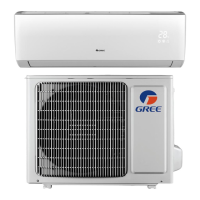
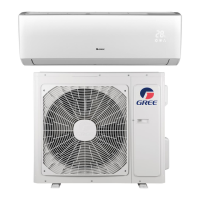
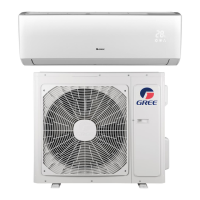
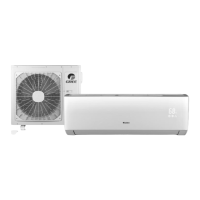
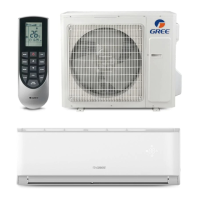
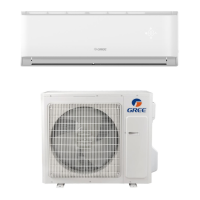
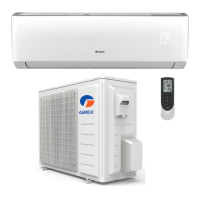
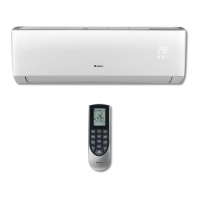



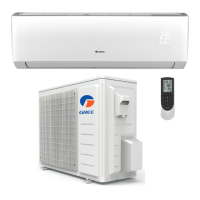
